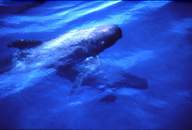|
Iberia was the European demographic reservoir during the last Ice Age (01/2005)
By studying mitochondrial DNA, which is passed from mother to child, researchers have found that most of the actual European inhabitants seem to have come from re-expansion of hunter-gatherers populations, which have migrated from Iberia, Europe after the end of the last Ice Age reports an article in the January issue of Genome Research 1
In the study of human evolution through history and pre-history there are now two indispensable sets of genes to follow: Y-chromosome and mitochondrial DNA (mtDNA) genes. Both sets are transmitted uniparentally from one generation to the next - father to son in the case of the Y-chromosome and mother to child in the case of mtDNA - which makes them especially useful to trace lineages.
Mitochondrial DNA is a circular structure composed of 13 genes and exists, as the name indicates, in mitochondria, which are organelles responsible for energy production in the cell. Mitochondrial DNA sequences can be divided in different groups – haplogroups – according to genetic variations (or polymorphisms). Each haplogroup can then be divided into sub-clades (or sub-groups) according to further polymorphisms. Because it is possible to calculate the changes occurring in mtDNA in a certain period of time (the rate of change is constant and known) it is possible to follow in time the different sub-clades and learn when they did get separated, and consequently their individual migrations/geographical separations.
And in fact, the study of mtDNA haplogroups has been used to understand better the migrations of human population throughout evolution. Unfortunately, this has not been possible in Europe, although some progress has been made on a relatively rare haplogroup V. But around half of the European mtDNA sequences belong to a haplogroup (H) and so far it had been impossible to understand its evolutionary pathway in the continent.
But now Luísa Pereira, Martin Richards, Ana Goios, Vincent Macaulay, António Amorim and colleagues from Spain, Israel, Russia, Germany, Dubai, Czech Republic and Ireland, taking advantage of recently available information on haplogroup H polymorphisms, decided to make a new attempt to understand the European migrations throughout evolution. The team of scientists analysed 649 individuals of the H haplogroup from 20 populations throughout Europe, Caucasus and the near East and, by managing to trace the localisation of the different sub-clades, were able to further resolve the evolutionary (and migrational) history of haplogroup H and modern Europeans.
In fact, it is believed that haplogroup H evolved in the Near East around 28.000-30.000 years ago and spread throughout Europe 20.000 years ago. Although it was thought that some, or all, of the European population of this haplogroup have re-expanded throughout the continent from a European glacial refuge 15.000 years ago, this was not possible to be confirmed. Now Pereira, Richards, Goios, Macaulay, Amorim and colleagues’ work not only confirms that in fact the oldest lineage of H (called H*) was found in the near East and entered Europe during the peak of the last Ice Age, but also claims to have identified the glacial refuge in Europe from where humans re-expanded as Iberia.
Pereira, Richards, Goios, Macaulay, Amorim and colleagues’ work is important for the history of human evolution suggesting that most modern Europeans evolved from hunter-gathers that expanded at the end of the last Ice Age (end of the Palaeolithic) from a glacial refuge in Iberia where they have stayed for around 10,000 years after an initial migration from the Near East.
 1 Genome Research (2005); Vol. 15, pp. 19-24 1 Genome Research (2005); Vol. 15, pp. 19-24
“High-resolution mtDNA evidence for the late-glacial resettlement of Europe from an Iberian refugium”
Original paper’s authors
Link to the original paper
|
In collaboration with the Observatório da Ciência e do Ensino Superior (OCES)
Financed by the Fundação para a Ciência e Tecnologia (FCT) |





